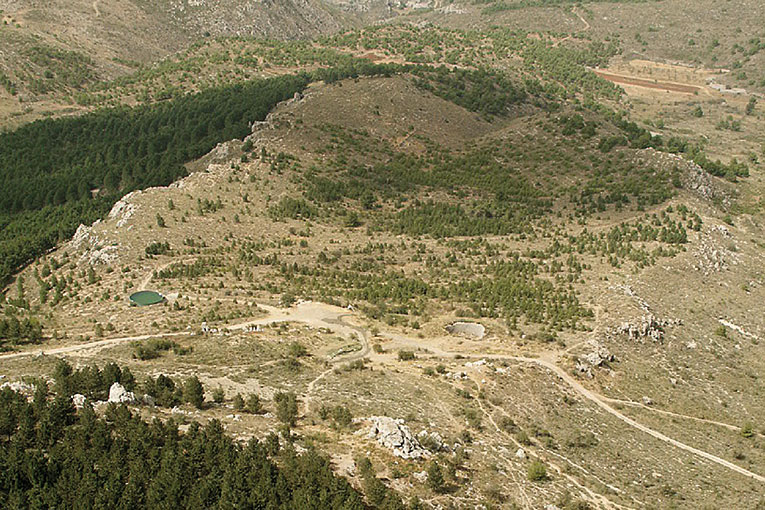
|
Snow pits and climate evolution Ever since 1970, in the first Spanish comprehensive study on this area, when geographer Horacio Capel drew attention to the value of the study of traditional ice industry to demonstrate a progressive climate warming, snow pits were used as indicators of the end of the Little Ice Age in the Mediterranean mountains. This period –spanning between the fourteenth and nineteenth centuries, albeit without agreement among experts– was characterised by an overall decrease of 1-2 ° C on average, as well as by the presence of exceptionally cold winters in Europe. Accordingly, these stores were built basically since the beginning of the Modern Age until the nineteenth century. Their distribution in altitudes where snows are currently very limited or nonexistent implies immediate relations between the increase of snowfalls in the past and the impossibility of its operation today. In Valencia, Jorge Cruz and Josep Maria Segura outlined in 1995 the first full catalogue with nearly 300 pits (Cruz and Segura, 1996), which also showed this apparent evidence of climate change in the Valencian mountains: almost 17% of them are less than 600 meters above sea level. From this basic study, the inventory and history of some of these pits has improved locally, regionally or provincially in recent years, mainly on the assumption that in the past there were more extreme winter weather conditions than in the present. Despite this, however, we must not forget that the use of snow as well as the cold traditional industry that derives from it is a human activity which, as such, requires more in-depth studies from economic and social points of view. This is why it is noteworthy that, despite the interest these works arise, the only comprehensive study developed with an economic objective in Valencia is the book by José Mallol, published in 1991, that deals with snow trade in Alicante during the eighteenth century. The climate reality that describes this author, after careful consultation of municipal documentary sources, does not seem to differ much from the present situation, with years of a «good snow harvest» and others with exceptional snowfall, but also years with no snow in the mountains of Aitana and Mariola, main Alicante suppliers. Non extraordinary snows in mountain areas have left few or no rest in the archives, which hinders the development of comparative studies. Because we have documentary evidence of all kinds, the Valencian climate of the eighteenth century is quite familiar, thanks to works such as Armando Alberola’s (2014), while the hypothetical end of the Little Ice Age in the nineteenth century Orihuela has been studied in a monograph by Ruth Zamora (2002). However, but for extraordinary events like the extreme cold temperatures suffered in 1784, 1792 or 1864, snow behaviour is still largely unknown, and the same applies to the first half of the twentieth century. |
«In the Region of Valencia,nearly 300 pits, which also showed this apparent evidence of climate change in the Valencian mountains: almost 17% of them are less than 600 meters above sea level»
|
|||
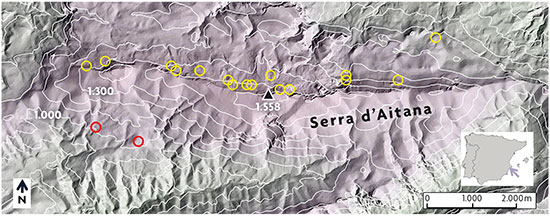 Mètode MètodeLocation of snow pits in the Aitana mountains. At the bottom, on the left hand side, the last two pits (red dots) built in the nineteenth century, at around 1000 meters above sea level on the south-facing slope. |
||||
 Arxiu de la Diputació d’Alacant Arxiu de la Diputació d’AlacantLedger of the pit, with the ratio of snow loads of 1846. |
«But for extraordinary events like the extreme cold temperatures suffered in 1784, 1792 or 1864, snow behaviour is still largely unknown» | |||
|
Last snow pits in Aitana Against this background, the history of the last snow pits built in the Aitana mountains presents some peculiarities that make it a very suggestive case study. First, the characteristics of the highest peak of southern Valencia, 1,558 meters above sea level, which represents a real climatic border whose uniqueness resides in both the quantity and continuity of snow, as described by Juan Antonio Marco (2001). Next, the date and location of the snow pits, because they were built in the 1830s and 1840s on the sunny side of the mountain at less than 1050 meters of altitude. We have to bear in mind that the rest of the eighteen snow pits located in Aitana were built between the sixteenth and the eighteenth century, on the northern side of the mountains at 1,250 meters above sea level or more. On the other hand, the documentary records available for these nineteenth century snow pits are noteworthy. These documents, once owned by Eduardo Soler Pérez (1853-1907), professor at the University of Valencia, are now deposited in the archives of the Province of Alicante. Of the two pits built in the town of Confrides, near the farmhouses named La Torreta (1830-1831) and San Joaquin (1840), only the former has been preserved, and whose activity we have been able to trace back to the end of the century. San Joaquin pit was abandoned after two years of its construction. The motives behind this situation remain unknown, although Soler suggests the possibility of competition with La Torreta, which supplied mule drivers carrying fish from the coast to Alcoy and El Comptat as well as other villages around like Villajoyosa, El Campello, Relleu, Orxeta, Sella, Finestrat, Penàguila and Benilloba, or Oran with snow. The owner’s documents contain monthly sales data for some years, which, nevertheless, does not allow us to build a thorough set of data. Documentary sources, however, are rich enough to establish a sufficiently reliable outline of the life of the pit and to contextualise it in the still scarce climate studies of Valencia in the nineteenth century. La Torreta was built during what was considered a wet and cold phase with exceptional snow levels that ended around 1840. This decade, when the San Joaquin pit was abandoned, is marked by a terrible drought in which, against all odds, La Torreta gathered some snow, as happened in 1846, known as «the hunger year» due to scarce precipitations. The time spanning between 1861 and 1879 is also considered a cold phase in which there was an advance of European glaciers as well as significant snow precipitation throughout Spain. Regarding this fact, Soler literally refers to this period as a «moment of glory» for La Torreta (between 1860 and 1865), a period in which we find exceptional snowfall in Orihuela and other places. From 1878 onwards, data shows that the pit entered a downward spiral, which corresponds to the last twenty years of the century, considered humid, albeit with a sharp increase in temperatures. In his plant studies in the Alicante mountains during that summer, the German botanist Friedrich Hegelmaier described La Torreta as containing but a small amount of snow stored, while the snow pit of Puig Campana (970 meters above sea level) is described as abandoned and destroyed. And at this very moment, with or without the increase of minimum temperatures, the advent of a key technological innovation that meant the decline of snow pits arrived –industrial ice factories. On June 3, 1888 the first ice factory in Alicante opened, close to El Postiguet beach. Years later, on the occasion of the opening of the new factory in L’Alcoraia in 1896, the prestigious architect José Guardiola Picon wrote in the newspaper El Ateneo: Anyone who has witnessed operations of snow collection, and its storage in pits, has had the chance of seeing the poor conditions this process involves; it is gathered just anywhere, either in perfectly clean lands, or ponds and areas impregnated with noxious vapours; and it is transported on old mats and using other means the press in Madrid has highlighted quite recently. Instead, ice is manufactured with water from Alcoraya by using a system that will be disclosed later on and whose foundation is the finest cleaning. The manufacture of artificial ice also ensures a constant presence of this product throughout the seasons, thus avoiding unfortunate situations occurred in the past, when finding snow could be difficult in cases of imminent danger when it was sought by description. All this put together with its uniformity and low price ensures a continuous success. With numerous commercial, seasonal and hygienic advantages, ice from the mountains and its traditional activity that made it possible for centuries could not compete with the new industrial development. In the 1890s, La Torreta pit, by them roofless, was marginally collecting snow. In early 1893 the stored snow was sold in Alicante and Villajoyosa at 5 pesetas per 15-pound load. Later on its price fell to 2 pesetas, until in 1895 «the pit could not be filled because there had not been enough snow». These are the latest documentary references offered by the owner. |
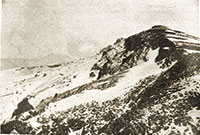 Soler y Pérez Soler y PérezThe hill of Ventisquer, near the peak of Aitana, covered with snow at some point between 1890 and 1900. Photography by Leopoldo or Eduardo Soler Pérez published in the journal Geografía general del Reino de Valencia (General Geography of the Kingdom of Valencia) (1900-1914). |
|||
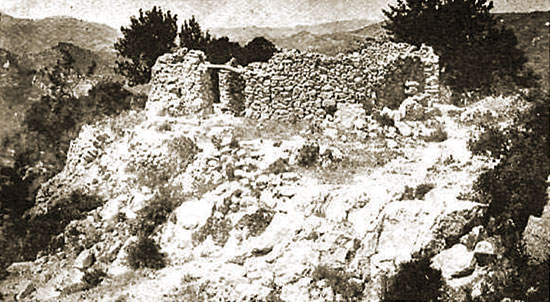 La Esfera (1927) La Esfera (1927)La Torreta snow pit, abandoned, photographed in the 1890s by Leopoldo Soler Pérez. |
«La Torreta was built during what was considered a wet and cold phase with exceptional snow levels that ended around 1840» | |||
|
Paleoclimatic indicators? Once acknowledged the cycle of this unique nineteenth century snow pit, its study provides interesting clues to try to answer questions still open about our recent climate history. Does the distribution of these pits suggest actually more stringent climate conditions than today’s? Certainly, we still need more complete studies in order to better understand the distribution networks of snow to explain the construction of some pits. Some of these, such as those located below 400 meters above sea level, could be understood as local stores of imported snow for immediate consumption. So, does the use of these pits and their decline coincide with the Little Ice Age? Nevertheless, the scientific community has not reached a consensus regarding this climate oscillation, and many consider that there is no real evidence of this negative trend of the weather throughout the nineteenth century. Can we therefore consider some snow pits as paleoclimatic indicators? The history of the last snow pit built in the Aitana mountains seems to fit the weather patterns that confirm the general trend, with slight variations, to an increase in temperature and a decrease in the number of snowfall as well as their duration. However, further documentary evidence and new case studies are still needed in order not to put evidence as suggestive as those discussed here erroneously together. The reconstruction of climate throughout history, even for moments as close to the present as the nineteenth century, poses many challenges that can only be addressed through a combination of several sources and analysis techniques. Historical documentation in its various aspects provides potentially valuable information, but we must interpret them correctly in their socioeconomic context to draw the appropriate climate conclusions. |
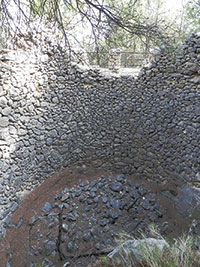 Grup d’investigació MedSPai – Universitat d’Alacant The snow pit, at present, hidden in a dense pine forest on the land of La Torreta (Confrides, Alicante). Grup d’investigació MedSPai – Universitat d’Alacant The snow pit, at present, hidden in a dense pine forest on the land of La Torreta (Confrides, Alicante). |
|||
|
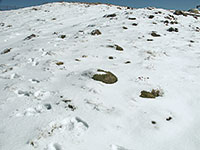 Grup d’investigació MedSPai – Universitat d’Alacant
|
|||
|
REFERÈNCES Pablo Giménez-Font. Full Professor at the departament of Regional Geographic Analysis and Physical Geography. University of Alicante. |
||||
Alberola, A., 2014. Los cambios climáticos. La pequeña Edad del Hielo en España. Cátedra. Madrid.
Capel, H., 1970. «Una actividad desaparecida de las montañas mediterráneas: el comercio de la nieve». Revista de Geografía, 4(1): 8-41.
Cruz, J. i J. M. Segura, 1996. El comercio de la nieve. La red de pozos de nieve en las tierras valencianas. Generalitat Valenciana. València.
Mallol, J., 1991. Alicante y el comercio de la nieve en la Edad Moderna. Ajuntament de València. València.
Marco, J. A., 2001. Aitana como espacio singular. Perspectiva geográfica de una montaña mediterránea. Publicacions de la Universitat d'Alacant. Alacant.
Zamora, R.,2002. El final de la Pequeña Edad del Hielo en tierras alicantinas. Publicacions de la Universitat d'Alacant. Alacant.







